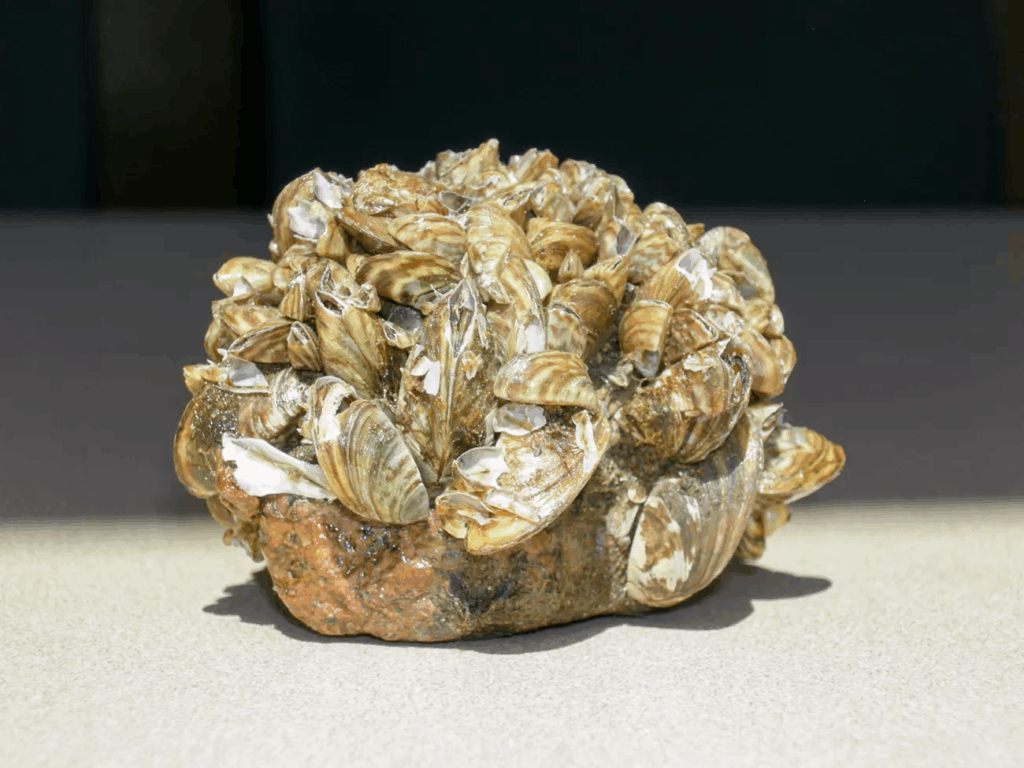Zebra Mussels, known as Dreissena polymorpha, are a type of mussel native to the Caspian and Black Seas in eastern Europe. As the name suggests, they have a body that is light in color, with repeating stripes that zig-zag along their top shell. Their shells form somewhat of a D shape and are flat on the bottom. This flat bottom allows them to effectively cover surfaces and attach firmly with protein structures called “byssal threads”. Zebra Mussels are able to spread quickly, cause environmental impacts, and are very difficult to deal with once established in an area.

Due to the strong, thread-like attachments that Zebra Mussels create, they can attach to ships very effectively and be easily brought into new environments. This process is called “Biofouling”, and is one of the most impactful traits that these mussels exhibit. This biofouling can cause problems in new environments because the mussels have a tendency to latch onto anything they can find. Boats, docks, rocks, and even other mussel species native to the environment. These mussels have become a particular problem in North America (i.e., the United States, Canada) due to their capability to spread so quickly.
Though it is the cause of their spread, Biofouling is not the only impact that Zebra Mussels have. When they move into a new environment, zebra mussels often create problems for native mussels in this new area. In addition to using their byssal threads to attach to these native mussels, zebra mussels are also highly efficient in their filtration feeding process. This involves drawing in small particulates of plankton from the surrounding water. Due to their extreme efficiency and large populations, zebra mussels can quickly clear out their surrounding area of any plankton particles. This causes great problems for any species in that area that consumes plankton as a main food source. This can also cause issues further up the food chain, as plankton are generally primary consumers in most habitats which they reside in. Disruptions in the bottom levels of the food chain can cause problems for even the highest level predators. Due to all these impacts, scientists have been working towards finding ways to deal with the issue of Zebra Mussels.
Dealing with Zebra Mussels is extremely difficult. Unfortunately, they are nearly impossible to remove from an environment once a population has been established. Prevention is the best method to keep waters clear of them. One major issue with prevention, however, is that females of this species can release up to one-million eggs a year, with each mussel being completely microscopic from egg to the final larval stage known as the “veliger”. Due to the inability to see these veliger, the movement of this species often comes from “infected” water becoming trapped in or around boats, and being moved to new environments. As part of prevention, boat owners should be careful to drain boats when they are done using them, as well as allow them to completely dry before using them again. Zebra Mussel buildup comes from surfaces that are placed into water for extended periods of time, so taking smaller vessels out of the water when not in use is also a great way to help prevent unwanted hitchhikers like these mussels.
Zebra Mussels are a fascinating type of mussel, and without care, could be brought to new ecosystems and cause detrimental effects. Taking preventative measures could help stop the spread of this invasive competitor.